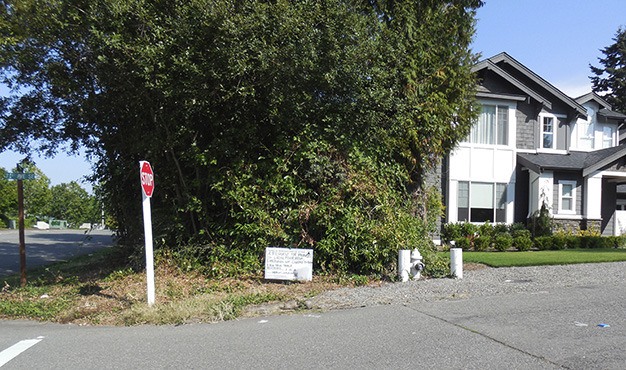A tiny lot at the corner of 71st Avenue S.E. and S.E. 22nd Street has brought a neighborhood together in protest as a couple wishes to build a new home.
The lot – just 2,300 square feet in size, was purchased by a couple from Redmond who wish to build compact but modern house on the land which faces north toward the tennis courts at Aubrey Davis Park.
Despite its small footprint, it is zoned R-96 for a residential structure with a minimum lot size of 9,600 s.f. Yet, the lot, originally some 6,000 s.f. was cut in half when the state condemned land for construction of the lid over Interstate 90 in the 1970s.
While the size of the lot was the primary point of contention, neighbors are also at odds with the design of the house, which they contend is too tall and out of character from the rest of the people who live along 71st Avenue S.E.
The applicants for the home, had requested variances from the city to allow narrowed setbacks and an increase the gross floor area and the amount of impervious surface. The present allowed limit for gross floor area is 45 percent. The applicant was asking for 77 percent.
City Development Services staff recommended that the variances regarding reduced setbacks should be allowed. Yet, city staff recommended that increases in the gross floor area and impervious surfaces, be denied.
Changes in setbacks and the adjustment in the gross floor area or impervious surfaces would allow the three-level structure to have projections from the roof – such as an overhang over the front door or a bump-out that would allow a bathroom to hold a full size tub, or a cover over a walkway. In order to add more living space, the applicants could build a basement to increase the size of the home.
However, City planner, Shana Crick said that the small size of the lot does not preclude it from construction of a residential structure. These variances involving the setbacks will allow a building on the property, she said.
Crick said that staff had determined that a home built there, “would not injure” the area or neighborhood around it.
The width of the lot is 25 feet wide. The structure itself will be 12 to 13 feet wide.
At a meeting with King County hearing examiner, Anne Watanabe, nine people spoke about the proposal including the applicant. The others were neighbors who spoke passionately against the tiny house, saying it was out of character for the neighborhood that has been changing to accommodate families with children. Some argued it could possibly cause traffic impacts at the corner. Other said that it was a dangerous precedence for the city to allow homes to be built on such small lots.
Most relied on the most obvious characteristic of the lot — its tiny size.
Island realtor Laura Reymore spoke first. She represented Jennie Warren who purchased the home on the south-side of the lot just a few years ago. She noted that at the time of the transaction, it seemed improbable if not impossible that someone would choose to built on the site. Warren said the new house would have a detrimental effect on her privacy and her children.
Reymore said that she consulted with fellow real estate professionals about the proposal. One told her that if the variances were approved it would benefit the applicant and his property values but diminish the property values of the neighbors.
Colin Kwong, the applicant also spoke at the hearing held at the City Council chamber at City Hall. He turned toward his potential neighbors as he spoke. He said that he and his wife, Ming Fung, want to become a part of the neighborhood.
He described the concept of the narrow building as being “cozy, simple, modern and elegant.”
“That is the vision I have,” he said. “We just need a bit of wiggle room to make it work,” he continued, referring to the setbacks needed to accommodate the ‘projections’ from the roof and deck.
Neighbor Brian Mock rejected that idea, saying that the applicant knew the lot needed variances to the code from the city, when he purchased the lot.
“It represents a ‘shoehorn’ lot, that will interfere with existing uses,” he said. “It should not be allowed. It will set a poor example and open the door to similar variances that would compromise the existing character of the Island.”
Jon Abrahamson, a builder who also lives on 71st Avenue S.E., said that the space is simply too small. Referring to the park and the available street parking adjacent to the lot, he said “it is an attempt to use public space as private space.”
His wife, Teresa noted that in the 16 years they have lived on the street, the houses have certainly changed, yet none as much as this one.
She always believed that the empty lot might be converted to a pea patch or some other community use.
Wanatabe, the hearing examiner will make a decision regarding approval of the variances in the next few weeks.


